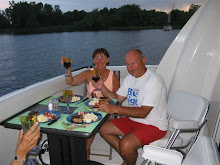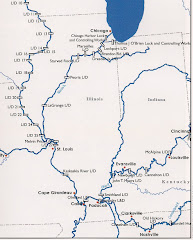(Sept. 25 – Dist: 60.8 mi; Avg Speed: 8.7 mph; TTT: 8:00 hrs)
The first thing that gets you when you leave Grafton Marina and enter the Mississippi River is the current. It is fast and there are constantly swirls and eddies in the water which move your boat back and forth. Otto could not handle it so I was at the wheel the whole time.
 What also surprised me was the scenery. There is no doubt the river is muddy, very muddy and ugly looking but the shoreline was quite interesting; lots of limestone cliffs and even a flock of American White Pelicans.
What also surprised me was the scenery. There is no doubt the river is muddy, very muddy and ugly looking but the shoreline was quite interesting; lots of limestone cliffs and even a flock of American White Pelicans. We stopped at Alton, IL for fuel and a pump out. This would have been another good stop but it is just one hour from Grafton. Two of the other boats got through the lock just past Alton while two of us were still refueling. It was a quick lock with no commercial traffic at the time so we locked through shortly after the first boats. The lock master warned us that the next pool was at flood levels so we had to be mindful of the current especially around the St. Louis Harbor. The Loop, the end of the Illinois River, enters the Upper Mississippi River at mile 218. Mile 0 is at the point where the Ohio River dumps into the Miss R. From there south to New Orleans is referred to as the Lower Mississippi.
St. Louis was disappointing. There are no marinas or any places to stop in St. Louis and now I know why. The currents are fierce, the barges and tugs were numerous and active, the shoreline was mostly industrial and the water was filled with debris. Lots and lots of floating debris made the driving in the currents difficult.
And then there were the ever present tow barges. A new record for us was set this day. We passed on oncoming tow that was pushing 39 barges; 6X6 +3.
After a fairly stressful day of driving we arrived at our destination for the night; Hoppies Marina in Missouri. I come to find out that the stress had only just begun. You see, Hoppies marina consists of three 100 foot barges lashed end to end and floating on the edge of the Mississippi channel. As we arrived we were instructed to be ready to throw a bow line first, followed quickly with a spring line and then a stern line. There were four people at the dock / barge to help us in. Why??? Serendipity went first and got in no problem. Of course Mitch is a professional captain and it showed. The next docking did not go as smoothly. It seemed to take forever for the boat to creep up to the dock and then just as it appeared to be near the dock the boat was swept away back into the middle of the river. The two of us that were waiting to get in were out fighting the current. I discovered a sweet spot. By running just one engine I could keep the current just off the bow and travel straight at about 0.6 mph. Not bad, a 450 hp diesel engine going 0.6 mph. In calm water this same engine will push my boat about 5 mph. Anyway it was time for the second pass for the boat that was trying to dock. Slow, slow, slow, ABORT, ABORT. For the two of us waiting in the middle we could not figure out what was happening. On the third attempt the captain was getting second by second instructions over the radio. I was listening intently and soon realized that this was not like any other docking that I had ever attempted. The third try was a charm and then we were up.
We started towards the dock but had to dodge a ton of debris, trees and logs. Then there was a large whirlpool to avoid which I later discovered was the end of a “wing dam”. I will explain these after I am docked. I kept a steady pace towards the back of the previous boat working very hard to keep the bow from swinging with the current. I had to keep a fair bit of momentum into the current and as we got close Linda made a perfect toss with the bow line and a second perfect toss with the spring line. I could hear one of the dock hands yell, “can you reach me?. The toss; he said good throw; I heard Linda reply, “there is no fu@#*^g way I am doing this again.” We made it first attempt. It is not as easy as one would think. The current is so strong that it grabs even large boats and it is difficult, most times impossible, to get it back.
Hoppies is unique and the owner Fern is legendary. Because boating on the Mississippi is different than everywhere else, Fern holds a briefing session everyday that new boats arrive. Even boaters who have travelled the river before will sit in on the sessions to learn the latest that is happening on the river. We learned about “wing dams” and “weir dams”. All along the Mississippi the US Army Corp of Engineers has constructed rock dams that run from the shore to the edge of the channel of the river in order to redirect the current and to minimize shoaling and shore damage.
The photo above was taken on the Cumberland River. It is obvious because that river is at normal or below normal pool levels. On the Mississippi we were at flood levels so we could not see them. As we learned the water was so high that we could safety travel over them. The briefing gave us a much better appreciation of the river and the changing water levels. It happens regularly enough that boaters are instructed to add 3 feet of water below when anchoring because the river could drop that much over night. Fern warned us about three areas of weir dams that created particularly bad turbulence. We were instructed to stay as far as possible on the opposite side of the river when passing these areas. We were also told of narrow sections with tight corners. Here it was recommended to call out a securite, securite warning to the tow captains so that you would not come face to face with a large tow and then have nowhere to go. She also went over all of the anchorages because there are no marinas for almost 200 miles. An excellent briefing that was greatly appreciated by all.
That night was a little disconcerting. Debris, wood and branches were slamming against the hull and scratching all the way back. I hate to think what Q’s bottom looks like. And then there was the barge traffic. Tows going upstream created such a surge and wake that the boat was bounced around for about 15 minutes each time one passed. The next day was a bit foggy and rainy so the girls decided that we were not going to travel. I set up the satellite dish and invited the guys over to watch football. A wasted day in our opinion until the girls came back all excited and energized. Evidently, the town of Kimmswick is a great and popular visitors stop. Bus tours regularly bring visitors including special days called “girlfriend day tours”. The Blue Owl is almost world famous. I can attest to the great desserts from their bakery and Linda can attest to the great shops. She really, really enjoyed the afternoon. We also discovered that the Anheuser Estate Museum was adjacent to the Hoppies property.
Since the restaurant closes at 5 PM we had our second meal in a row onboard.
The river looks tame here but don’t be fooled.















No comments:
Post a Comment